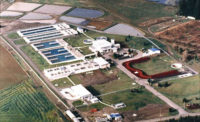Researchers at the University of Buffalo measure the corrosion level of a steel-cable strand using a non-invasive monitoring technique, aimed to replace structurally invasive manual checking processes for concrete-embedded steel cables on bridges.
“Checking post-tension structures for corrosion is a challenging problem,” says Alireza Farhidzadeh, a University of Buffalo PhD candidate in structural engineering. He says projecting the accurate evolution of corrosion to a cable is nearly impossible because of a variables such as the salting of roads during the winter and the rain and snow levels during the year. Structurally invasive corrosion monitoring techniques are required, such as drilling into the concrete to check structural cables manually, he says.
To create a non-invasive technique, Farhidzadeh and his team outfitted a seven-wire cable strand with eight piezoelectric transducers and sent guided ultrasonic waves (GUWs) to monitor any changes in frequency as the corrosion level evolves.
“Measuring velocity and the time of flight of the frequencies sent out, you can localize where the corrosion or micro cracks occur in the cable,” says Farhidzadeh The permanently attached transducers allow the team to perform real-time passive structural monitoring and routine inspections, without seeing the cable.
The research consists of three phases, two of which are complete. The first was to evaluate the seven-wire strand cable under load to create a baseline for the following tests. The second phase was submerging the cable in a saltwater tank with 2-volts DC current running through, creating accelerated electrochemical corrosion.
“We monitored the level of corrosion, day by day, until the strand broke,” says Farhidzadeh. For the last test, researchers will load the strand, pour concrete on it and wait for concrete to cure, then run the same test.
“We can corrode the steel in less than a month,” says Tresor Mavinga, a senior civil engineering undergrad who is working on the project.
Testing the strand under load was enough to give researchers a baseline frequency measurement and an idea of how corrosion of the strand changes the frequencies produced by GUWs.
Farhidzadeh and his team will release a paper detailing their findings in January. The third phase of testing is ongoing.






Post a comment to this article
Report Abusive Comment